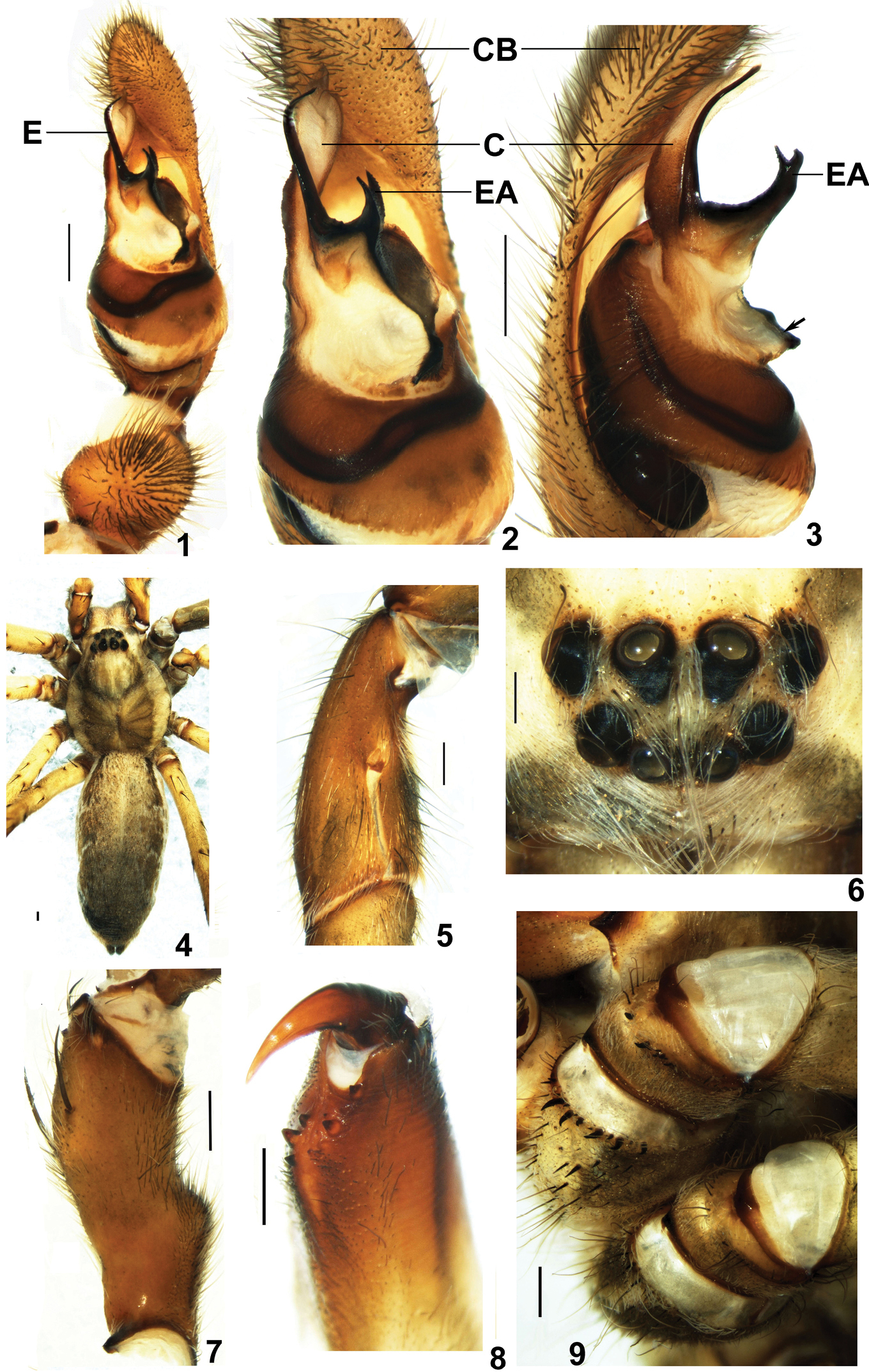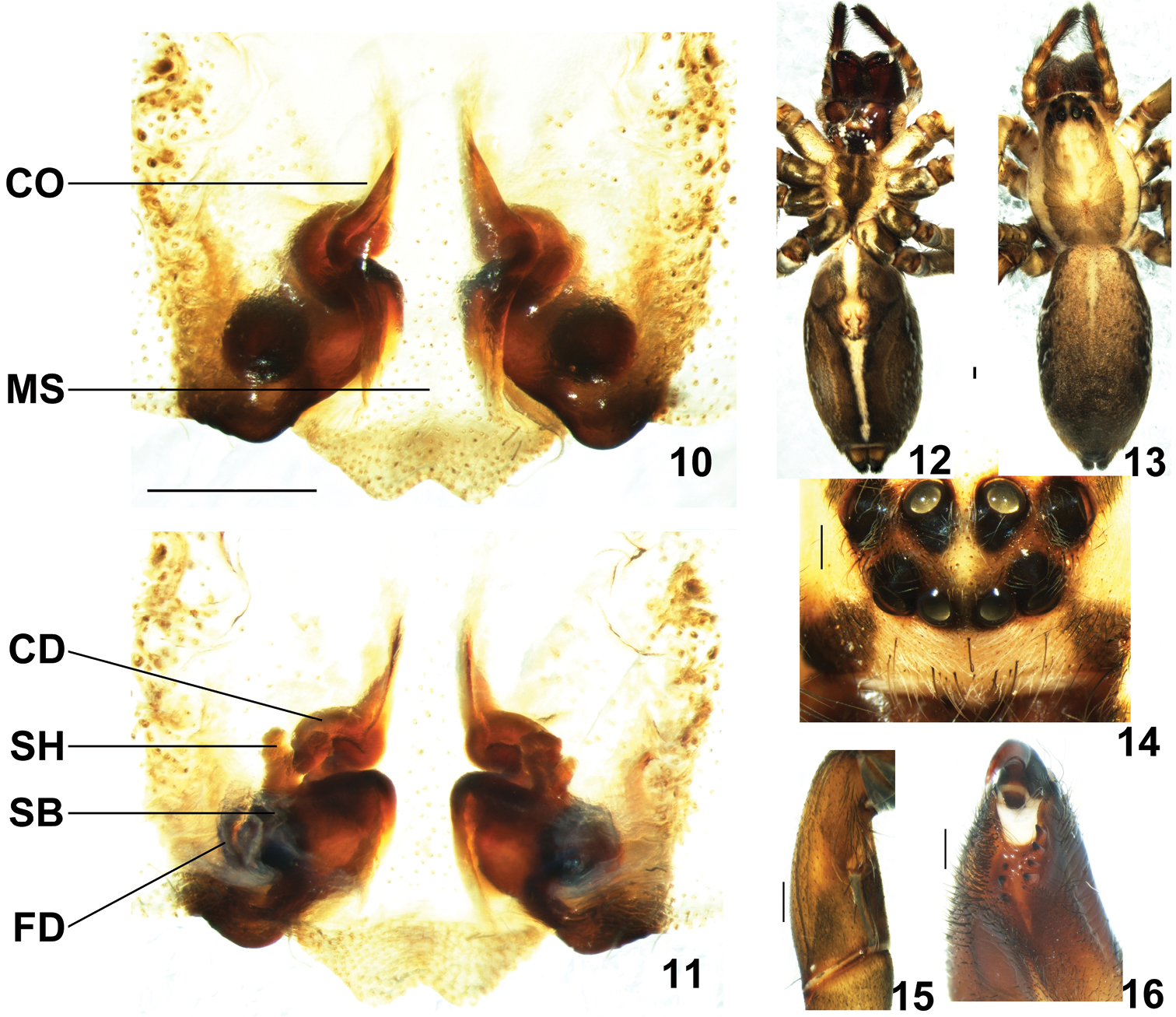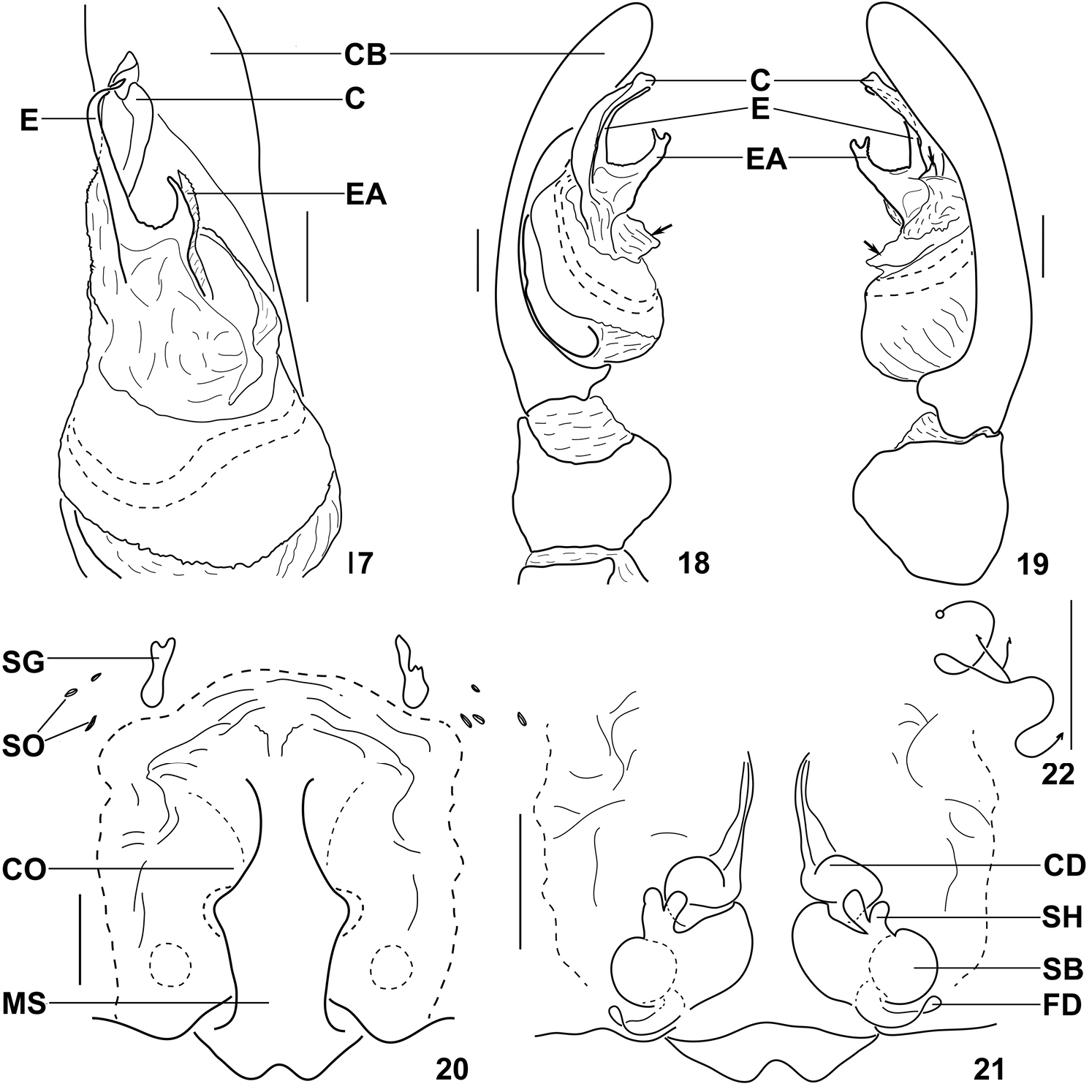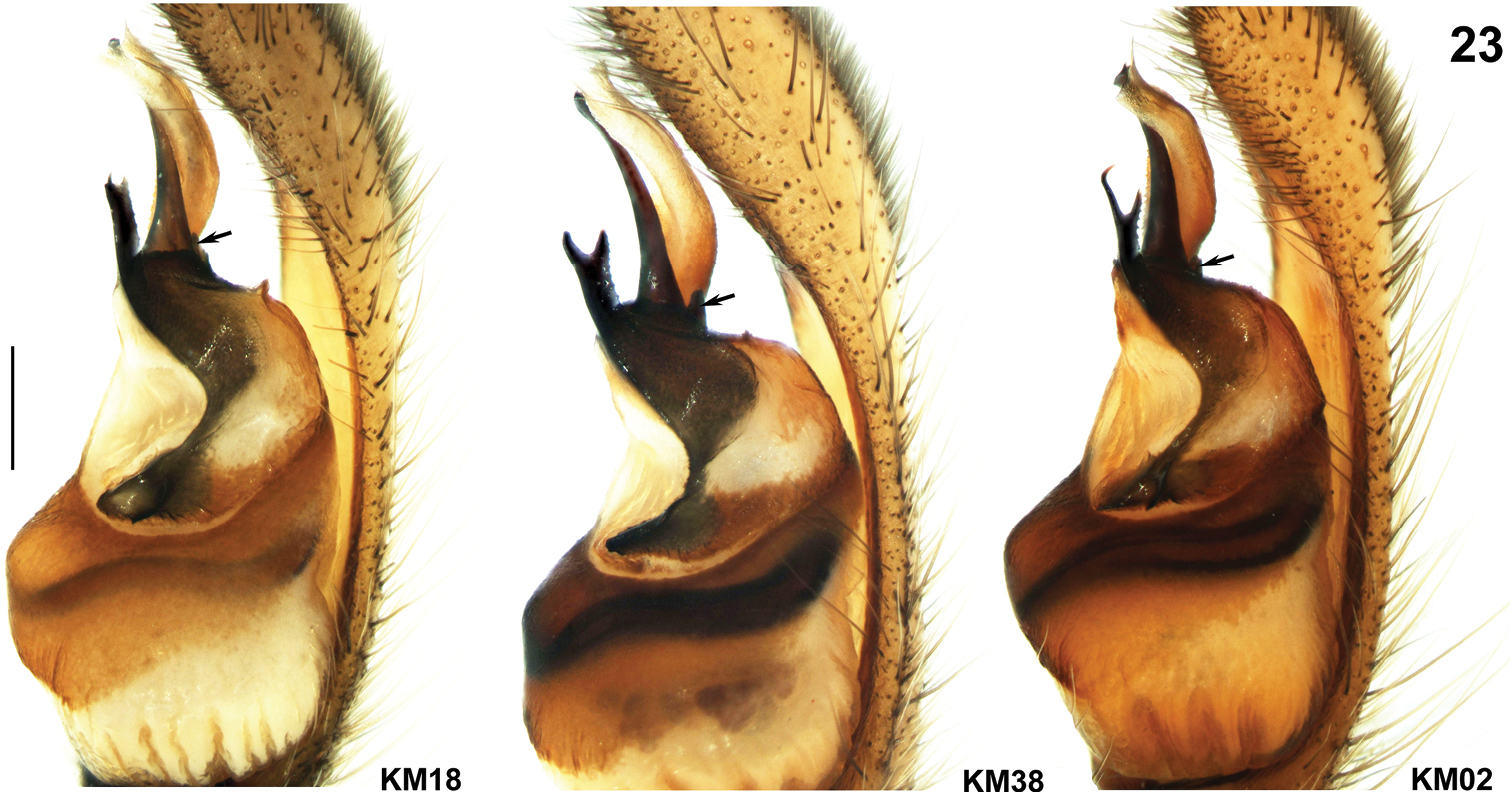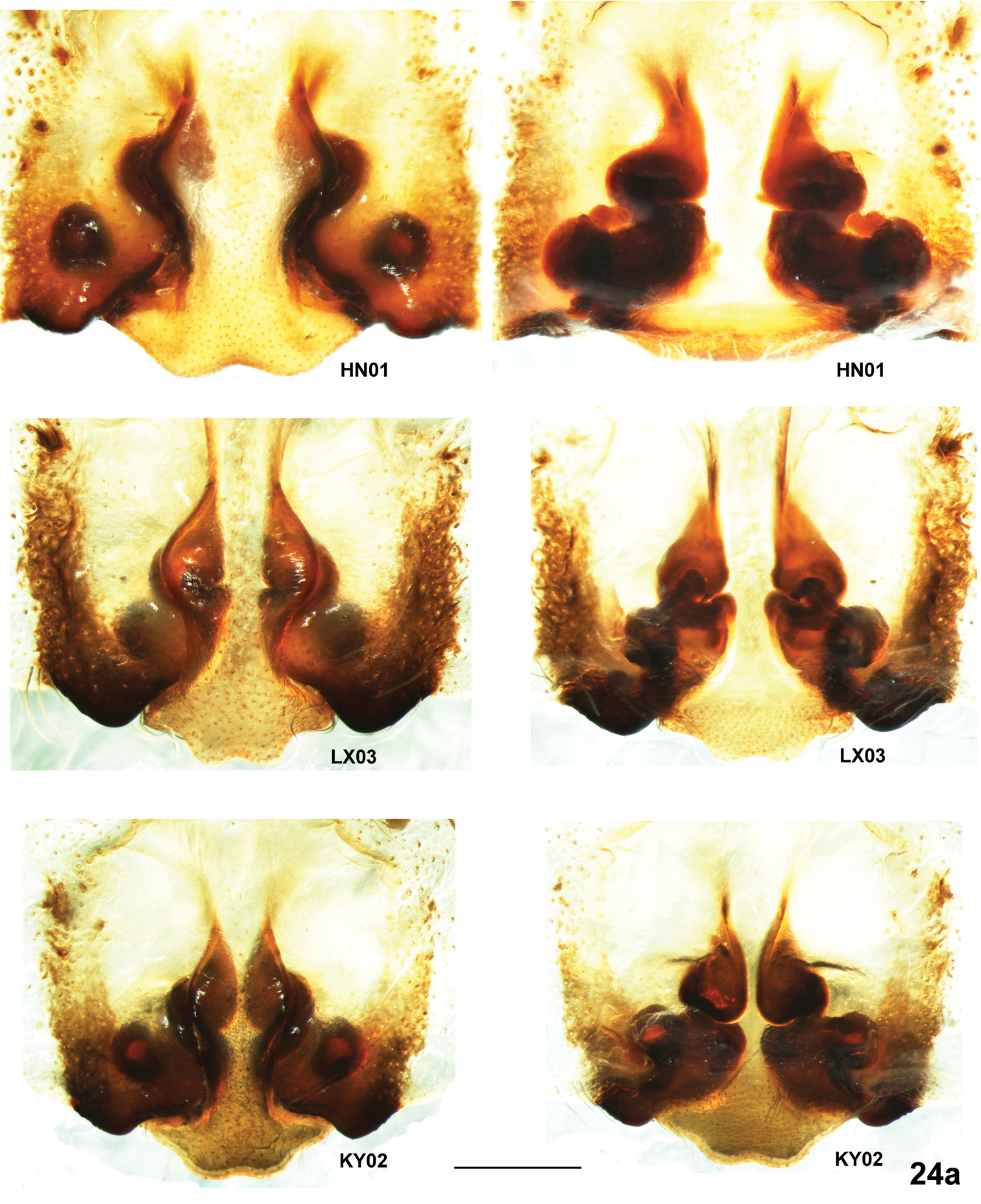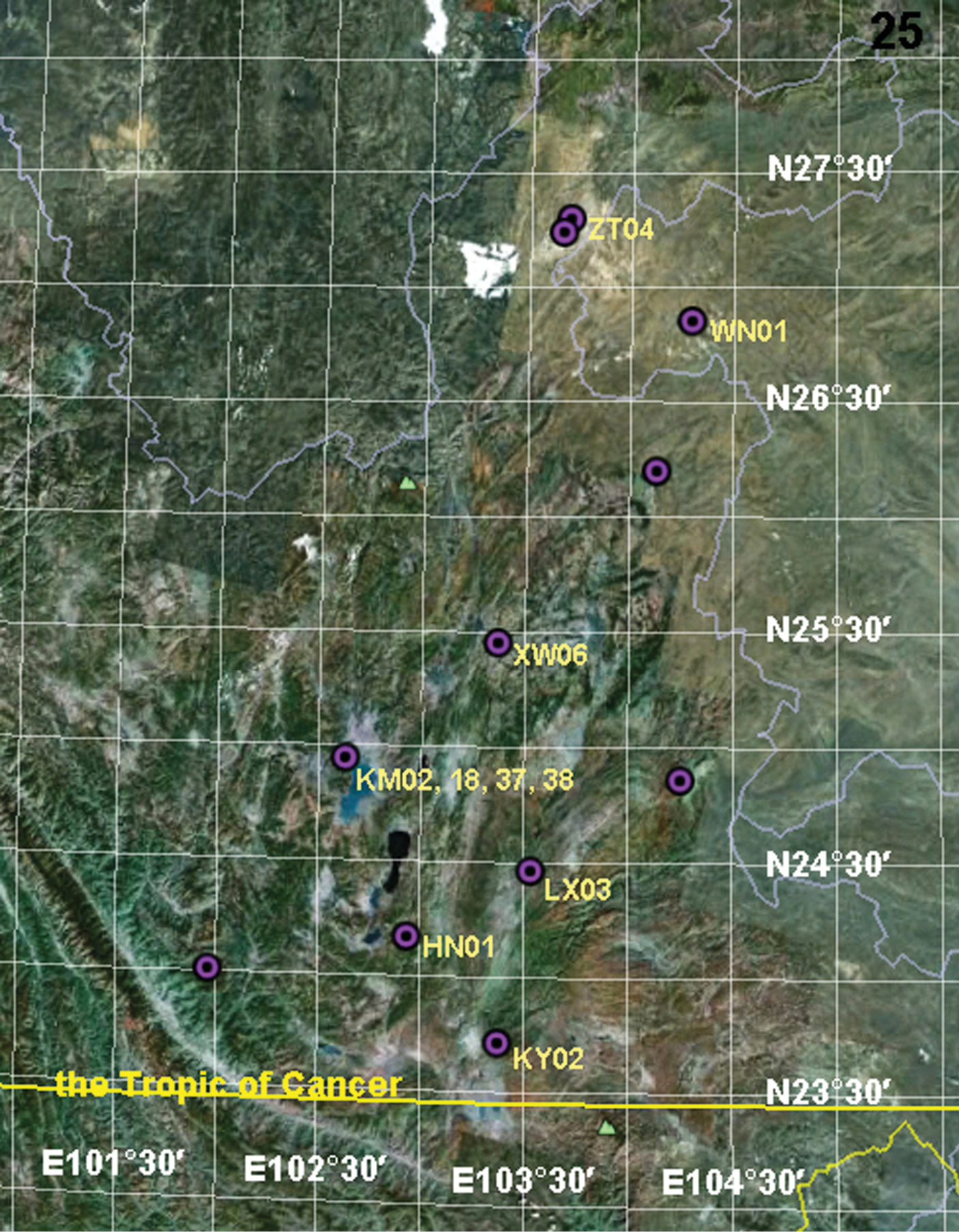






(C) 2012 Ping Feng. This is an open access article distributed under the terms of the Creative Commons Attribution License 3.0 (CC-BY), which permits unrestricted use, distribution, and reproduction in any medium, provided the original author and source are credited.
For reference, use of the paginated PDF or printed version of this article is recommended.
Psechrus kunmingensis Yin, Wang & Zhang, 1985 was first described from the female only. The first illustration of the male appeared without any text description and lacked other critical information. For this study, we collected fresh specimens of this species from diverse localities around Yunnan Province, China. Here, the male is described in detail for the first time and a supplementary description of the female is given. Based on the largest collection of Psechrus kunmingensis specimens ever assembled, we found a remarkably high level of morphological variation in this species.
Araneae, taxonomy, intraspecific variation, morphology
Psechridae Simon, 1890 is a small spider family with 2 genera, 46 species (
Psechrus kunmingensis was described and illustrated for the first time by
We examined specimens collected from the type locality of Psechrus kunmingensis (Kunming, Yunnan Province, China) at the same time of year (April to July) and many specimens from places around Kunming. Based on examination of these specimens, we concluded that the male illustrated by
Specimens were preserved in 75% ethanol. Female copulatory organs were dissected and cleared in 90% lactic acid for a few minutes. Photographs were taken with Nikon digital Sight DS-Fi1 mounted on Nikon SMZ1000 Stereoscopic Zoom Microscope. Copulatory organs were illustrated using Adobe Illustrator CS5, with a Wacom Bamboo CTL-660 pen and tablet device. Illustrations were rendered in Adobe Photoshop CS5 Extended.
All measurements are in millimeters (mm), and taken with Nikon NIS-Elements Imaging Software Br (version 2.34). All scale bars are 0.5mm length. We measured two male specimens and 5 female specimens to obtain size range data. Specimens were selected to cover the widest possible size range. The “prosoma length” or “opisthosoma length” respectively refers to length of the main part of prosoma or opisthosoma , without spinnerets and petiolus. The whole “body length” is regarded as length from clypeus to the posterior tip of opisthosoma. Every individual was given a code, consisting of abbreviation of the locality and a sequence number. For instance, “KM18” represents a specific specimen collected from Kunming. Non-quantitative descriptions of somatic morphology are based on KM37 (female) and KM38 (male). Palpal and leg spination pattern is given as: prolateral, dorsal, retrolateral, ventral (the latter digit may be omitted in the case of the absence of ventral spines) (
ALE–anterior lateral eyes, AME–anterior median eyes, PLE–posterior lateral eyes, PME–posterior median eyes; C–conductor, CB–cymbium, E–embolus, EA–embolic apophysis; CD–copulatory duct, CO–copulatory opening, FD–fertilisation duct, LL–lateral lobe, MS–median septum, SB–spermathecal base, SG–muscle sigilla, SH–spermathecal head, SO–slit sense organ; I, II, III, IV–legs I to IV.
Taxonomyhttp://species-id.net/wiki/Psechrus_kunmingensis
Figs 1–24China, Yunnan Province:Xi Shan, Kunming, 2260m, 24°57'24.3"N, 102°37'43.7"E: 4 ♂ (KM01-04), 6 ♀ (KM05-10), 27-IV-2004, Zi Zhong Yang leg.; 5 ♀ (KM11-15), 27-IV-2004, Zhi Sheng Zhang leg.; 1 ♂ (KM18), 5 ♀ (KM16-17, KM19-21), 2 subadults (KM22, KM25), 12 juveniles (KM23-24, KM26-35), 20-IV-2011, Ping Feng and Yan Yan Ma leg.; 1 ♀ (KM36), 07-IX-2011, Zi Zhong Yang leg.; 1 ♂ (KM38), 1 ♀ (KM37), 04-V-2011, Zong Xu Li leg.. Maguohe township (by the 101 provincial road), Malong county, Qujing, 1880m, 25°27'50.7"N, 103°22'42.8"E, 3 ♀ (ML01-03), 18-VII-2012, Ping Feng and Ting Bang Yang leg.. Dong Shan, Xuanwei, Qujing, ca 2150m, 26°12'42.0"N, 104°08'15.6"E, 10 ♀ (XW01-10), 7 juveniles (XW11-17), 17-VII-2012, Ping Feng, Yan Yan Ma and Ting Bang Yang leg.. Yongfeng town, Zhaotong, ca 1930m, 27°14'55.6"N, 103°40'10.6"E, 1 ♀ (ZT01), 23-VII-2004, Zi Zhong Yang leg.. Fenghuang Shan, Zhaotong, 1970m, 27°18'30.0"N, 103°42'16.7"E, 4 ♀ (ZT02-05), 14-VII-2012, Ping Feng and Yan Yan Ma leg.. Huaning county, Yuxi, ca 1660m, 24°10'59.3"N, 102°56'45.2"E, 1 ♀ (HN01), 09-VIII-2002, Jin Yin Lu leg.. Mopan Shan, Xinping county, Yuxi, ca 1630m, 24°01'21.3"N, 101°58'15.7"E, 2 ♀ (XP01-02), 05-V-2012, Zi Zhong Yang leg.. Lukou village (by the 204 provincial road), Luxi county, Honghe Autonomous Prefecture, 1600m, 24°28'30.2"N, 103°32'35.7"E, 3 ♀ (LX01-03), 1 juvenile (LX04), 27-VII-2012, Ping Feng and Ting Bang Yang leg.. Kaiyuan (by the 323 national road), Honghe Autonomous Prefecture, 1980m, 23°43'27.7"N, 103°23'05.9"E, 5 ♀ (KY01-05), 1 juvenile (KY06), 26-VII-2012, Ping Feng and Yan Yan Ma leg.. Baila Shan, Luoping conty, Qujing, 1710m, 24°52'20.1"N, 104°15'37.2"E, 1 ♀ (LP01), 19-VII-2012, Ping Feng and Yan Yan Ma leg.. Guizhou Province: Weining county (by the 326 national road), Bijie, 2330m, 26°51'44.0"N, 104°18'15.2"E, 1 ♀ (WN01), 15-VII-2012, Ping Feng, Yan Yan Ma and Ting Bang Yang leg.
Kunming, Yunnan Province, China, 1 ♀ holotype, 5-IV-1979, Jia Fu Wang leg.; 3 ♀ paratypes, VII-1983, Ming Yao Liu leg.; 4 ♀, 21-VII-1981, Jia Fu Wang leg.
Maleresembles Psechrus sinensis Berland & Berland, 1914 (Wang & Yin 2001: 338, Figs 25–26), Psechrus tingpingensis Yin, Wang & Zhang, 1985 (Wang & Yin 2001: 340, Figs 31–33) and Psechrus triangulus Yang et al., 2003 (Yang et al. 2003: 45, Figs D-F) by having an embolic basal apophysis (Figs 1–3) and a rounded bulge with dense patch of hairs on the ventral palpal femur (Fig. 7); distinguished from these species by: 1) embolic basal apophysis long and distally bifurcated (Figs 1–3, 17–19); 2) much longer embolus (almost as long as the width of the tegulum) (Figs 2, 17); 3) distal section of embolus directed retrolaterally. Female copulatory organs similar to Psechrus sinensis (Wang & Yin 2001: 338, Fig. 28) and Psechrus jinggangensis Wang & Yin, 2001 (Wang & Yin 2001: 335, Fig. 12) by having coiled copulatory ducts; distinguished from these species by the posteriorly and laterally lobed epigynal median septum, which interlocks with lateral lobe, and folds inward; the spermathecal heads arise anteriorly at spermathecae (Figs 11, 24a, 24b).
Psechrus kunmingensis Yin, Wang & Zhang, 1985. Male (KM18). 1–3 left palp (1, 2 ventral 3 prolateral) 4 habitus, dorsal 5 left patella, retrolateral 6 eyes arrangement, dorsal 7 left femur , prolateral 8 left chelicera, retrolateral 9 left coxa I ventral. Arrow indicates a broad apophysis at embolic base. C conductor CB cymbium E embolus EA embolic apophysis (Scale bar 0.5mm).
Psechrus kunmingensis Yin, Wang & Zhang, 1985. Female (KM37). 10 epigyne, ventral 11 vulva, dorsal 12–13 habitus (12 ventral 13 dorsal, ) 14 eyes arrangement, dorsal 15 left patella, retrolateral 16 left chelicera, ventral. CD copulatory duct CO copulatory opening FD fertilisation duct MS median septum SB spermathecal base SH spermathecal head (Scale bar 0.5mm).
Psechrus kunmingensis Yin, Wang & Zhang, 1985. Copulatory organs. 17–19 male palp (17 ventral 18 prolateral 19 retrolateral) 20–22 female copulatory organ (20 epigyne, ventral 21 vulva, dorsal 22 Schematic course of internal duct system). Arrow in Fig. 18 and the lower one in Fig. 19 indicate the broad apophysis at embolic base; the upper arrow in Fig. 19 indicate the triangular apophysis besides embolus. C conductor CB cymbium E embolus EA embolic apophysis CD copulatory duct CO copulatory opening FD fertilisation duct MS median septum SB spermathecal base SG muscle sigilla SH spermathecal head SO slit sense organ (Scale bar 0.5mm).
Males (KM38 first, KM03 in parentheses): Body length 18.21 (15.05). Prosoma length 7.53 (6.46), prosoma width 5.89 (4.56), opisthosoma length 11.18 (7.37), opisthosoma width 5.08(2.93). Eyes diameter: AME 0.32 (0.34), ALE 0.39 (0.37), PME 0.35(0.37), PLE 0.43 (0.42). Distance between eyes: AME-AME 0.23 (0.18), AME-ALE 0.14 (0.08), ALE-PLE 0.53 (0.44), PME-PME 0.23 (0.25), PME-PLE 0.38(0.33), AME-PME 0.57 (0.56). Clypeus height at AME 0.85 (0.76), clypeus height at ALE 0.80 (0.69).
Carapace brown, with a gray band at central part and white hair along the margin (Fig. 4). Cervical groove and fovea with dark stripe (Fig. 4). Eight eyes arranged in two recurved rows, eye region with long white hairs (Fig. 6). Sternum light brown, with an inverted triangle dark mark and long hairs. Labium deep reddish brown; gnathocoxae brown. Chelicerae yellow at basal part, and reddish brown at terminal part, with 3 promarginal, 5 retromarginal teeth, and 3 denticles (Fig. 8). Legs yellow to reddish brown; Coxae and trochanteri of the first walking legs with short macrosetae in a distal row each (Fig. 9). Patellae of legs with a slit at retrolateral side (Fig. 5). Dorsal opisthosoma dark gray, with a pair of longitudinal black patches at lateral side, and pairs of white radiative patches. Ventral opisthosoma with a white band, from pedicel to cribellum.
Male palp: distal 1/3 part of dorsal palpal CB with dense scopula. Embolic base with a long and distally bifurcated apophysis (Figs 1–3, 17–19); conductor close to embolus, almost joined together along their entire lengths. In retrolateral view, there is a small triangular apophysis (as indicated by arrows) beside the embolus (Figs 19, 23); Tegulum with a broad apophysis (as indicated by arrows) under embolic base (Figs 3, 18–19). Sperm duct visible through tegulum, follows slightly meandering path ventrally (Figs 1, 2, 17). Palpal tibia very short, with dense patch of hairs at retrolateral side (Fig. 1); palpal femur with a rounded bulge and dense patch of hairs (Fig. 7).
Psechrus kunmingensis Yin, Wang & Zhang, 1985. Intraspecific variation of male palp, retrolateral. Arrows indicate the triangular apophysis besides embolus (Scale bar 0.5mm).
Spination of palp and legs as shown in Table 1; Measurements of the palp and legs as shown in Table 2. KM38 first, KM03 in parentheses. Leg formula: 1423.
Spination of palp and legs of Psechrus kunmingensis Yin, Wang & Zhang, 1985
| Male | Femur | Patella | Tibia | Metatarsus |
| Palp | 131 | 000 | 000 | – |
| I | 625 | 000 | 3038 | 4041 |
| II | 526 | 000 | 3036 | 3035 |
| III | 536 | 000 | 2033 | 3035 |
| IV | 435 | 000 | 3024 | 3035 |
| Female | Femur | Patella | Tibia | Metatarsus |
| Palp | 131 | 020(010 right) | 012 | 2031 |
| I | 525 | 000 | 3037 | 2025 |
| II | 525 | 000 | 3036 | 2025 |
| III | 425 | 000 | 2034 | 3035 |
| IV | 543 | 000 | 2034 | 3045 |
Measurements of palp and legs of Psechrus kunmingensis Yin, Wang & Zhang, 19850
| Male | Femur | Patella | Tibia | Metatarsus | Tarsus | Total |
| Palp | 2.94(2.81) | 1.24(1.06) | 1.08(0.96) | – | 3.55(3.00) | 8.81(7.83) |
| I | 14.04(11.99) | 3.70(3.00) | 17.36(14.12) | 16.18(13.07) | 6.83(5.83) | 58.11(48.01) |
| II | 12.50(10.42) | 3.21(2.76) | 12.97(10.71) | 12.58(10.33) | 5.09(4.69) | 46.35(38.91) |
| III | 9.13(7.69) | 2.72(2.25) | 7.89(6.55) | 8.55(7.13) | 3.75(3.43) | 32.04(27.05) |
| IV | 12.80(10.27) | 3.10(2.33) | 12.98(10.30) | 13.14(10.95) | 5.60(5.30) | 47.62(39.15) |
| Female | Femur | Patella | Tibia | Metatarsus | Tarsus | Total |
| Palp | 2.74 (2.74–3.38) | 1.18 (1.05–1.61) | 1.32 (1.45–1.61) | – | 2.29 (2.29–3.30) | 7.53 (7.53–9.90) |
| I | 10.11 (9.98–10.17) | 3.27 (2.85–3.27) | 11.52 (10.24–11.52) | 9.41 (8.84–9.41) | 5.11 (4.26–5.11) | 39.42 (37.96–36.45) |
| II | 8.31 (8.31–11.93) | 2.78 (2.43–3.40) | 9.06 (8.40–13.27) | 7.61 (7.28–11.09) | 4.23 (3.89–5.82) | 31.99 (30.79–45.51) |
| III | 6.94 (6.66–7.55) | 2.28 (2.05–2.42) | 5.93 (5.34–6.36) | 5.33 (5.04–6.16) | 3.33 (2.90–3.47) | 23.81 (21.99–25.96) |
| IV | 9.36 (8.91–10.57) | 2.53 (2.08–2.90) | 8.95 (8.28–9.50) | 8.02 (7.84–8.81) | 4.38 (4.15–4.38) | 33.24 (31.26–36.07) |
Females (KM37 first, together with those of others [KM05, KM06, KY02 and ZT04] given as ranges in parentheses): Body length 16.75 (14.17–20.30). Prosoma length 7.09 (5.15–7.50), prosoma width 5.07 (4.26–4.83), opisthosoma length 9.90 (8.52–13.46), opisthosoma width 5.08 (4.19–7.75). Eyes diameter: AME 0.33 (0.30–0.33), ALE 0.36 (0.44–0.47), PME 0.39(0.38-o.44), PLE 0.43 (0.41–0.47). Distance between eyes: AME-AME 0.20 (0.18–0.16), AME-ALE 0.11 (0.07–0.13), ALE-PLE 0.59 (0.42–0.55), PME-PME 0.29 (0.24–0.27), PME-PLE 0.34 (0.35–0.37), AME-PME 0.64 (0.55–0.53). Clypeus height at AME 0.75 (0.72–0.83), clypeus height at ALE 0.72 (0.71–0.81).
Coloration (Figs 12–13) as in male only generally darker; other characters as in male except as noted. Chelicerae with 3 promarginal, 5 retromarginal teeth, and 4 denticles (Fig. 16). Patellae of legs with a slit at retrolateral side (Fig. 15).
Female copulatory organ: the SO and SG are outside the epigynal field (the SO are anterior and lateral to the epigyne, while the SG are right anterior to the epigyne); the MS lobed at the posterior and lateral edges; there are many wrinkles at the epigyne, especially at the anterior part (Fig. 20); the shadow of the round spermathecae is evidently visible through the ventral view of epigyne (Fig. 10). Copulatory ducts coiled; the spermathecae is mostly covered by folds of LL and MS; the spermathecal heads arise anteriorly at spermathecae (Figs 11, 21). The incision at posterior margin of MS, shape of lobes of MS, the length of CD and shape of SH vary a lot (Fig. 24a, b); schematic course of internal duct system shown in Fig. 22.
Psechrus kunmingensis Yin, Wang & Zhang, 1985. Intraspecific variation of female copulatory organ (left row, epigyne, ventral; right row, vulva, dorsal). (Scale bar, 0.5mm).
Psechrus kunmingensis Yin, Wang & Zhang, 1985. Intraspecific variation of female copulatory organ (left row, epigyne, ventral; right row, vulva, dorsal). (Scale bar, 0.5mm).
Note. Illustrations given in previous publications about Psechrus kunmingensis were wrong with the arising position of the spermathecal heads or the position of the spermathecae.
Spination of palp and legs as shown in Table 1; Measurements of the palp and legs as shown in Table 2. KM37 first, those of others given as ranges in parentheses. Leg formula: 1423.
All 6 examined males were collected from the type locality. The distal fork of EA is relatively variable (Fig. 23): one male (KM18) with 2 short and tiny apophysis, some with relatively strong and blunt forks (KM01, KM04 and KM38), while others exhibit slender and sharp forks with the ventral one curved distally (KM02 and KM03).
All examined adult females vary in many aspects (Figs 10–11, 24a, 24b): 1) the number of SO varies from five (KM05, ZT01, HN01 and WN01) to seven (KM37 and KM36); 2) incision at posterior margin of MS is less distinct in some individuals (XW06, WN01, LX03 and KY02), but others are evident and symmetrical (KM37, HN01 and ZT04); The epigyne of female specimens collected from Zhaotong (the northernmost locality) to Kaiyuan (the southernmost localiy) show disciplinary changes: the lateral bulges of MS range from very sharp (ZT04) to really broadly rounded (KY02); the CD vary from broad and distinctly visible (KM37, HN01, LX03 and KY02 ) to almost invisible (WN01 and ZT04); almost the whole spermathecae are covered (KM37, XW06, ZT04) to more than half part spermathecae are exposed (HN01, LX03 and KY02); 6) spermathecal heads show huge variation in shape and length, and among the dissected vulvae, no two are exactly the same, even opposing sides of the same individual.
This research was supported by the National Natural Science Foundation of China (31060070), Project on Applied Basic Research of Yunnan Provincial Department of Science and Technology (2009CD092), and the scientific research open fund project of the Key Laboratory of Forest Disaster Warning and Control in Yunnan Province (ZK11SB07, ZK11B301). We are grateful to Professor Zhi Sheng Zhang (Southwest University, Chongqing) and Professor Feng Zhang (Hebei University, Baoding, Hebei) for the loan of specimens. Many thanks to Steffen Bayer (Senckenberg Research Institute and Natural History Museum, Frankfurt am Main, Germany), who kindly gave many useful comments on this manuscript, as well as specimens observation, photography and psechrid taxonomy. Also many thanks to Jeremy Miller (Naturalis Biodiversity Center, Leiden), for his valuable comments on this manuscript and improving the quality of English. We appreciate Peter Jäger and Xin Ping Wang and one anonymous referee for their helpful recommendations on this manuscript.
